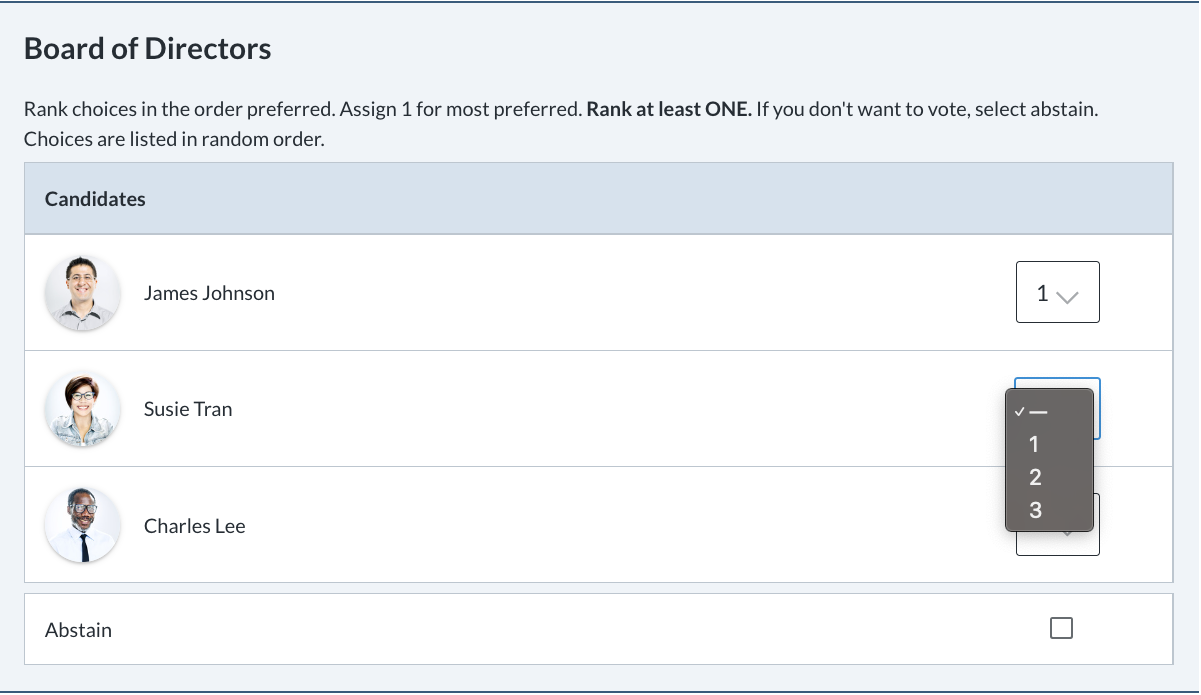Also known as Borda's Method or Borda Preferential Voting

In the Borda Count voting process, voters rank the candidates in order of preference. Each candidate is assigned a score based on their ranking. The highest-ranked candidate receives the most points, and the lowest-ranked candidate receives the fewest points. The voting process involves voters expressing their preferences by assigning a numerical value to each candidate.
To calculate the results using the Borda Count method, the points assigned to each candidate are tallied. The candidate with the highest total score becomes the winner. The points for each candidate are summed up, taking into account the rankings assigned by all the voters. The candidate with the highest score after the tallying process is declared the winner. Typically, the value assigned to each vote and preference is based on calculating the value based on the count of preferred items, using the formula n-1 where n is the number of preferences selected, though some organizations use an absolute preference, for example if a ballot has 4 candidates, and voter has 2 preferences, and defines them as 3 and 4 respectively, the point count would be 1 and 2.
The Borda Count is used to determine the outcome of an election based on the collective preferences of the voters. It provides a way to capture the overall sentiment of the electorate by considering the rankings given to each candidate. The Borda Count aims to provide a more nuanced representation of voter preferences compared to other voting methods. It takes into account the full range of preferences expressed by the voters, allowing for a more inclusive and representative outcome.
Let's use an example of an election with four candidates: Alice, Bob, Carol, and Dave. Voters are asked rank these candidates from their most preferred to least preferred.
Voter 1 ranks the candidates as: Alice, Bob, Carol, Dave
Voter 2 ranks the candidates as: Carol, Bob, Dave, Alice
Voter 3 ranks the candidates as: Bob, Carol, Alice, Dave
Voter 4 ranks the candidates as: Alice, Carol, Bob, Dave
Using the Borda Count method, each candidate receives points based on their ranking. For example, if there are four candidates, the first-ranked candidate receives three points, the second-ranked candidate receives two points, the third-ranked candidate receives one point, and the last-ranked candidate receives zero points. After calculating the points for each candidate based on the rankings assigned by the voters, the totals are as follows:
Alice: 9 points, Bob: 5 points, Carol: 7 points Dave: 0 points (too bad for Dave!)
In this example, Alice has the highest total points, making her the winner according to the Borda Count method.
No, The Borda Count has voters assign scores to candidates based on their preferences, and the candidate with the highest total score wins. Instant Runoff Voting has voters rank the candidates, and in each round, the candidate with the fewest votes is eliminated, and their votes are redistributed to the remaining candidates. This process continues until one candidate receives a majority.
In a Borda Count election, the candidate with the highest total score is declared the winner. The total score is calculated by summing up the points assigned to each candidate based on their rankings. The Borda Count takes into account the preferences of the voters and aims to determine a candidate who is generally preferred by the majority of voters, based on their cumulative rankings.